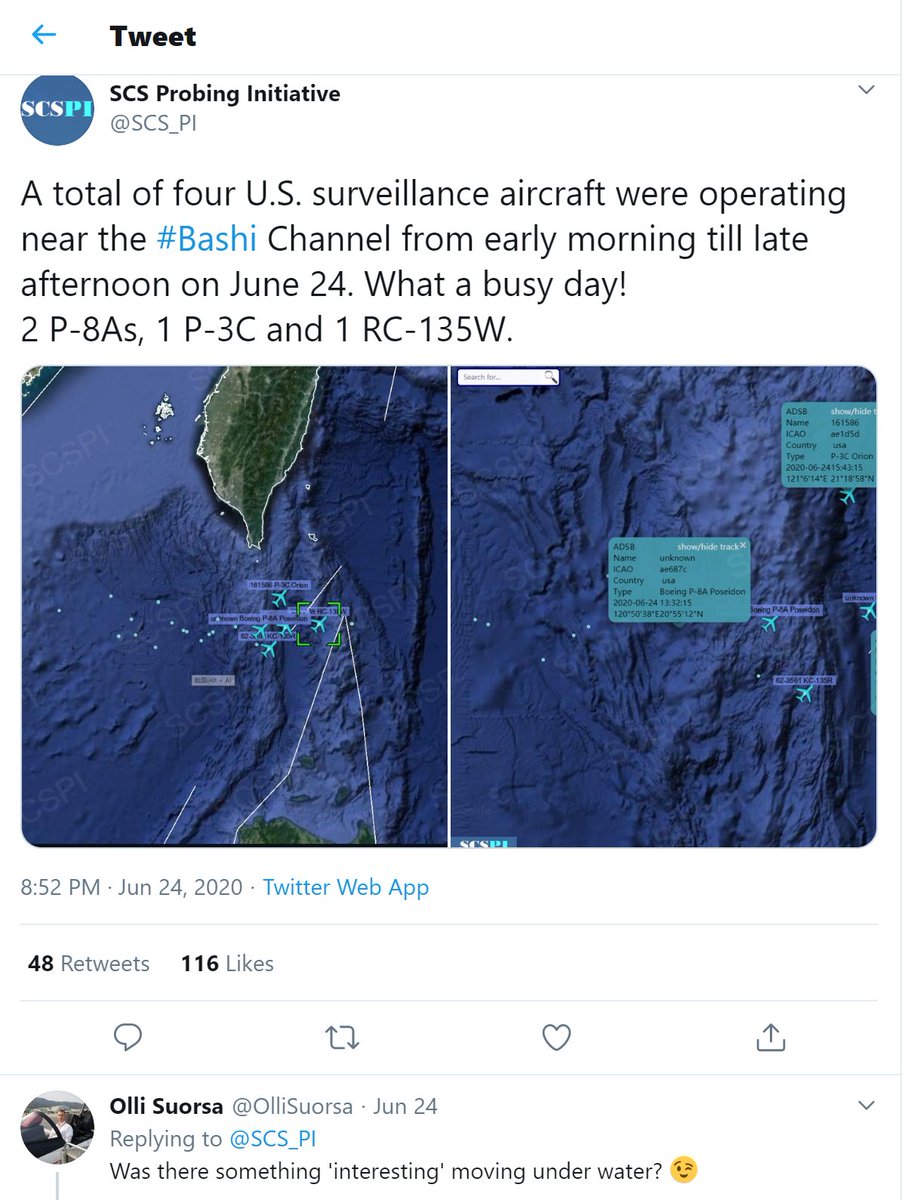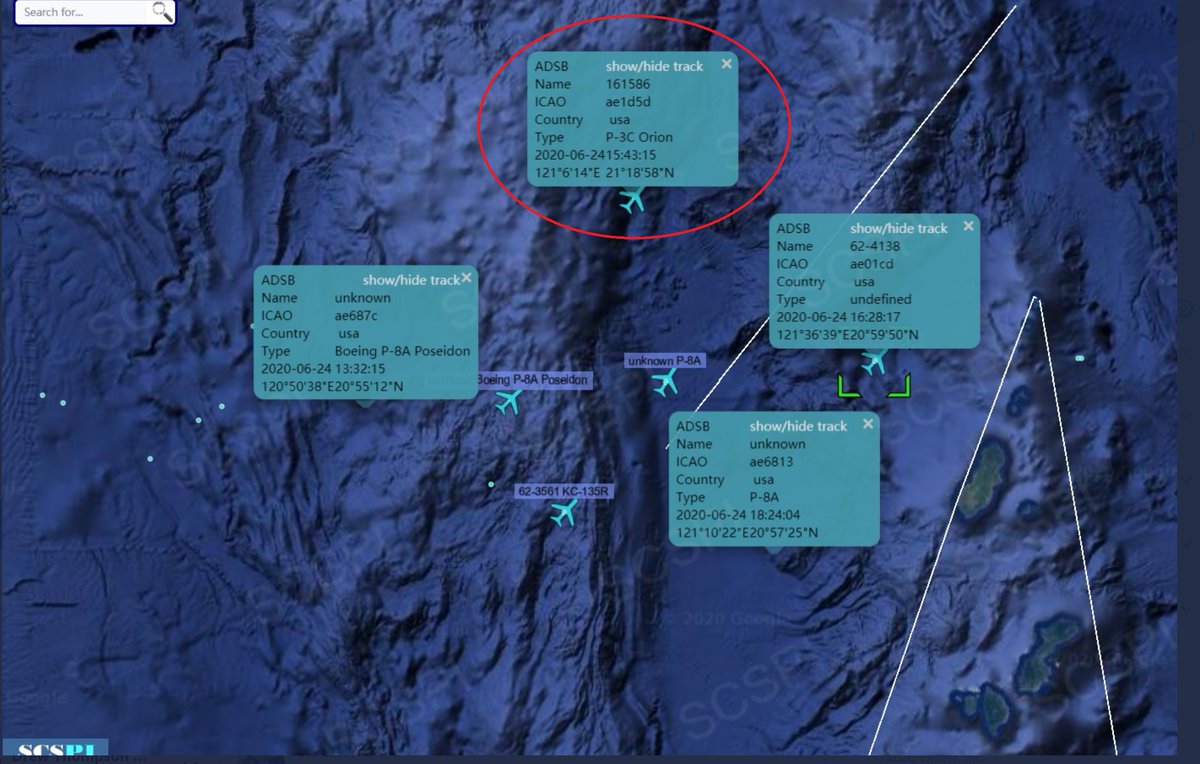Peking University& #39;s @SCS_PI observed two U.S. Navy P-8 Poseidon aircraft, one P-3C and a U.S. Air Force RC-135W Rivet Joint reconnaissance aircraft was operating to the South of Taiwan in the Bashi Channel.
One P-3C? Whose is it? It& #39;s probably Taiwan& #39;s.
A thread. /1
One P-3C? Whose is it? It& #39;s probably Taiwan& #39;s.
A thread. /1
The tweet did not mention that they were accompanied by a @usairforce KC-135R refuelling aircraft, enabling the planes to stay on station longer than if they could only rely on their internal fuel tanks.
Yes, USAF can refuel a @usnavy P-8! Air-Sea Battle lives!
/2
Yes, USAF can refuel a @usnavy P-8! Air-Sea Battle lives!
/2
My friend and colleague @RSIS_NTU here in Singapore, @ollisuorsa, wryly asked in a re-tweet, “Is there something ‘interesting’ moving underwater?
/3
/3
He presumes, correctly I believe, that a pair of U.S. Navy P-8 Orion aircraft had taken up station over an underwater target of interest, most likely a People’s Liberation Army (PLA) Navy submarine making its way through the Bashi Channel.
/4
/4
The military jargon for an operation to continually track and collect data on a submerged submarine is a “prosecution.”
/5
/5
With the USS Ronald Reagan @Gipper_76 carrier strike group operating east of Okinawa, a submarine picket in the Bashi channel is a standard measure to protect the carrier from Hainan-based submarines, and in this case, they have found a submarine to prosecute.
/6
/6
This graphic posted by SCSPI shows the formation of planes presumably over the submarine, demonstrating the strategic importance of the Bashi Channel, with Taiwan as the anchor of the First Island Chain.
/7
/7
SCSPI did not mention the lone P-3C, mislabelled in the SCS Probing Initiative graphics as belonging to the “usa.”
The U.S. Navy has retired all of its P-3C Orions.
The P-3C operating in this picture is most likely operated by Taiwan.
/8
The U.S. Navy has retired all of its P-3C Orions.
The P-3C operating in this picture is most likely operated by Taiwan.
/8
President Bush notified Congress of its intent to sell Taiwan 12 P-3C Orion maritime patrol aircraft in April 2001.
The first plane was delivered in 2013, the last in 2017, and the fleet was officially commissioned in December of that year by President Tsai @iingwen.
/9
The first plane was delivered in 2013, the last in 2017, and the fleet was officially commissioned in December of that year by President Tsai @iingwen.
/9
Taiwan faced challenges integrating the P-3C into its military. The P-3C is significantly larger and more complex than other aircraft in the Taiwan Navy’s inventory, presenting operating, logistics and maintenance challenges.
/10
/10
To overcome these issues, the P-3C is operated jointly by the Taiwan Air Force and Taiwan Navy, essentially with the Air Force flying it, and the Navy using it.
/11
/11
As a joint platform, Taiwan has been able to leverage the strengths of both services to quickly make the P-3C an effective maritime surveillance platform.
/12
/12
Anti-submarine warfare is a more complex discipline, however. The ocean is big, planes are small, and submarines don’t want to be found.
/13
/13
The U.S. transferred the aircraft with its associated sensors and weapons - including light-weight torpedoes and harpoon missiles – as well as training and simulators for Taiwan’s pilots to learn to operate the aircraft.
/14
/14
U.S. arms sales abroad always come with technical support to ensure that the recipient is able to effectively use it, giving the buyer a capability, not just a system.
/15
/15
However, anti-submarine warfare, like most submarine technologies are closely held secrets. @USNavy does not release very much info on anti-submarine warfare, leaving other countries to their own devices to develop their own doctrine and tactics.
/16
/16
It has undoubtedly been a steep learning curve for Taiwan’s Air Force and Navy to learn to operate the P-3C aircraft for not only a maritime surveillance role, but in an anti-submarine role as well.
/17
/17
Taiwan’s military has clearly made considerable steps, without much U.S. support to enable it to operate in a strategic waterway to prosecute a PLA Navy submarine in close proximity with U.S. forces.
/18
/18
To have the opportunity to loiter over a hostile submerged submarine with a P-3C will be a valuable experience for Taiwan’s military, giving them a valuable payoff from an important asset.
/19
/19
Is Taiwan& #39;s military jointly prosecuting this sub with the @USNavy and @usairforce? Is this evidence of improving US-Taiwan military relations? Probably not. Taiwan saw the U.S. P-8s circling, figured out what was going on, and sent their P-3C to join in the fun.
/20
/20
It does argue, however, for @DeptofDefense to share key technologies with Taiwan to improve interoperability. Taiwan should join the Link-22 tactical data link consortium so the US military can communicate securely with Taiwan platforms and benefit from their sensors.
/21 END
/21 END
@bikhim @CollinSLKoh @Project2049 @Stokes2049 @supbrow @AsstSecPM @shashj @niccijsmith @Sinostrategy @taiwandefense @globaltaiwan @ChinaMaritime @CovertShores @AsiaMTI @USPacificFleet - I hope you enjoyed the thread! Feedback always welcome.

 Read on Twitter
Read on Twitter




